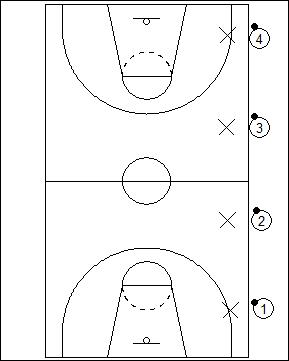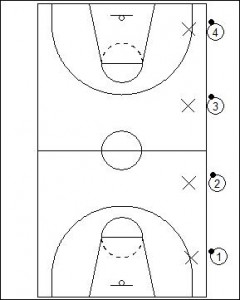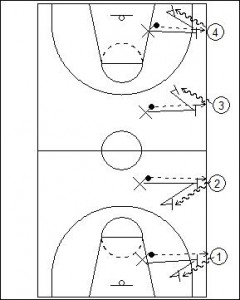Spear the Ball Drill Fab 5

The Spear the Ball Drill brings footwork, hand pressure spacing together. Individual defence for many players is something which requires constant attention and focus. For a defensive specialist nothing comes easy and very often the secret to being a good defensive player lies less in technique and more in effort, desire and concentration.
This drills kicks off our Fab 5 series focusing on drills specific to improving the defensive technique and application for the individual.
A lot of coaches never teach hand pressure or struggle to develop a consistent philosophy on how to manage this technique. Teachers have a saying “what I ignore I teach” meaning if you do not instruct a student/athlete in how you want them to act they will choose their own way of doing things. Hand pressure to some degree is instinctive so you must allow your players the opportunity to practice and make mistakes with regards to when to attempt to steal and when not to steal the ball from the offensive player.

The purpose of this drill is to establish defensive spacing to the ball, and additionally attempts to apply pressure on the offensive player with the intent of getting the ball out of the operating (shot pocket) area.
Start by have the defensive player straddle the offensive players jab step and have the defenders feet move in unison. Defenders feet are square to the sideline. Head on the high hip (direct the ball down the sideline). Offensive players on the sideline are in the left side alley. Defenders spear the ball with the left hand; right hand is the obstruction hand. Offensive players use a tight “C” with the ball and try to jab step a foot past the defence (each jab past a foot of the defence is a win for the offense.
Complete five jab steps to the left and complete five repetitions to the right. Remember the defensive player reacts when he initially sees movement anticipating the offensive player’s aggression, if the offensive player does not move the defensive player quickly closes the gap back to within an arm’s length between the defensive and offensive player.

Close out to appropriate defensive spacing, spearing the ball. Contain one dribble to dead pressure. Complete five jab steps and dribble to the left and complete five repetitions to the right. Offense starts on the lane line with the ball. In a point stance, they toss the ball underhanded to the offensive player and close out (two sprint steps to a hop). Offensive player attempts to get a jab step past a foot of the defence. Determine if the ball is in the right or left side alley. Offense jab step twice then try to beat the defence with one dribble. Defensive players contain the ball handler and once it is picked up call “Dead”.
It is important that while on the move defensive players ‘jockey’ the offensive player and maintain at least an arm bar of distance between the two players. Any closer and a foul is likely to occur and limit the ability to create ongoing and sustained pressure.
To advance the difficulty of the drill increase the allowed dribbles to two. Want more? Follow our series development as well look at drills developing individual (technical) and team (tactical) drill for teaching and instructing in defensive principles. The Fab 5 Drills Series is a grouping of drills selected to underpin basic skill instruction for the use by coaches at all levels featuring technical and tactical elements from both offensive and defensive situations.





Thankyou for the comment.
Here at Functional Basketball Coaching we are always looking for ways to pass on relevant information to our readers.
Feel free to pass on any subjects which you would like us to investigate into the future about coaching.
I’m extremely impressed with your writing skills as well as with the layout on your weblog. Is this a paid theme or did you customize it yourself? Anyway keep up the nice quality writing, it’s rare to see a nice blog like this one these days..
Hi Dana, thankyou for the feedback. At Functional Basketball Coaching we are always trying to raise the bar. Our theme was sourced independently.
Great articles. Could you please explain,in detail, the Tight C concept?
Thanks. Trevor Cook.
Thank you for visiting the site. Always great to know the articles are of use to coaches.
When I have used the teaching point of “tight C” in the past it has been a tool for triggering offensive players to move the ball from the front of their body to the side for heir body as they perform the Jab Step in this drill.
So visually when the player moves from a shooting stance into the jab step the ball movement from front to side looks like a “c”.
Because of the proximity of the defender in the Spear the Ball drill to the offensive player I always express this as a “tight action”. When performing the jab step I want to see the offensive player not extend their arms fully or become loose with the ball, but rather keep the ball within their cylinder with a short sharp action.
One point I tend to explain in addition to this is to maintain three points of contact by the offensive player with the ball. Two hands and the placement of the basketball on the hip as soon as practical in performing the jab step. I see this as a necessity to help if there is contact by the defender with the ball. Placement of the ball on the hip in this scenario will assist with the impact of the ball pushing it into the hip of the ball handler, rather then it popping free.
I hope this is of help.